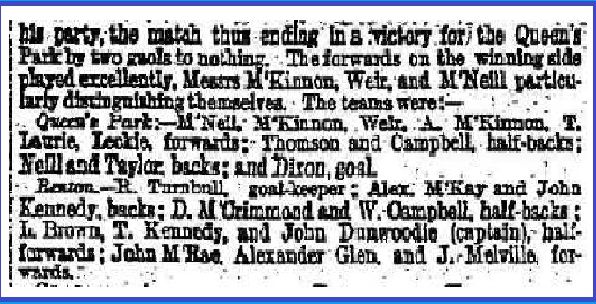The Scots Game's First Team?

On 13th December 1873 Queen's Park F.C. played a just third match ever at home at the First Hampden Park. The Spiders won 2-0. It was in the initial Scottish Cup and could be seen as the first of the Scottish Game, the distinctive Scottish Game. But it probably wasn't because this was third round and both teams had won at least twice already, very possibly employing the same formations as each used that day. And nor was it QP, as convention has been claimed for the last one hundred and fifty years, that tactically led the way. It was opponents Renton.

And the source of this claim is none other than The Scotsman newspaper. It confirms Queen's Park took the field with two full-backs, two half-backs and six forwards, 2-2-6, and that Renton did too. The previous season Vale of Leven, "The Vale", Renton's neighbours from a couple of miles up the road, had after the November 1872 Scotland-England international made it its own after QP had reverted to playing the English, the failing English 1-2-7 or 2-1-7. But it also specifically describes Renton as setting its attack in two rows of three in a 2-2-3-3, something it might have been doing for the previous two or three months. It is just that we don't have the confirmation.
But from December 1873 we, that is The World, did not get round to reading it. Moreover, we have the names of the players, who filled those positions, including the captain on the day, skipper and players who might be considered, after Robert Gardiner, the games second wave of genius. So who do we think they were and what became of them?
In goal R. Turnbull, Robert Turnbull, was a Block Printer, aged at the time twenty-three or twenty-four and living on Renton's Main St. at number fifty-seven. He was Renton-born too, as was his mother but his father had come from Dunipace, fitba' country. He would marry a Kinloch (see Alex Wylie blow) and his maternal grandmother was a Glen. He would live to eight-two and die in 1930, still locally in Dumbarton. And at full-back there were two presumably powerful men, Alex McKay and John Kennedy, the former a Blacksmith, the latter a Quarry Labourer. McKay was twenty-three or twenty -four, and in 1881 was living on quite possibly the most important street in football history, Thimble, at number sixteen. He had been born in Renton or possibly the village of Buchlyvie in Stirlingshire, so fitba' country once, and again probably die in Dumbarton, in his case at eighty-six. And in the meantime he had married and would raise family in Renton.
Back to Articles
or the SFHG Home page